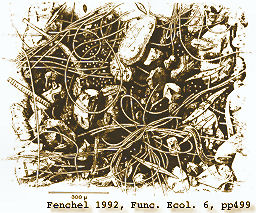Soil Structure by Dairyman Dave

Ed. (Sheila Newman) Last year I spent a lot of time editing with Alice Friedemann a new version of her essay, "Peak Soil" for a book called The Final Energy Crisis (2nd edition) Pluto Press, UK, 2008. I was impressed by the way her writing made the reader sit up and see that soil was not just dust and minerals, but alive. Here's a typical paragraph:
"There’s so much life in the soil; there can be 10 “biomass horses” underground for every horse grazing on an acre of pasture. Just a tiny pinch of earth could have 10,000 different species - millions of creatures, most of them unknown. If you dived into the soil and swam around, you’d be surrounded by thousands of miles of thin strands of mycorrhizal fungi that help plant roots absorb more nutrients and water. As you swam along, plant roots would tower above you like trees as you wove through underground skyscrapers."
When I read Dairyman Dave's explanation of soil structure, published below, although it is much shorter and quite different in style, I was similarly impressed by a capacity to evoke interest and understanding in what for most people is an invisible, indestructible firmament, taken for granted.
Soil structure by Dairyman Dave
When I was very young, 18, I remember taking a college course on agronomy, taught by an old professor with white hair. Many years later I realized the values he was trying to teach us. It became clear that he wasn't too fond of the direction that agribusiness was taking agriculture but he had clout and was "allowed" to speak his mind some of the time. For example, he taught us how hybrid corn was made and why but at the same time he pointed out that non-hybrid corn could be just as good and to prove it he always planted some in his test plots so he could show us. Of course, I couldn't have cared less at the time.
He retired the next year; they finally got him out of the way. He also posted a philosophical truth across the blackboard each day which no one paid any attention to, of course.
This man stressed the importance of soil structure and spent time explaining what it was and how it is made and what destroys it. Again, I couldn't have cared less at that time of my life; the course was required. I was into engineering, high tech stuff, important stuff.
I will try to explain soil structure. Think of the World Trade Center buildings before they collapsed. They had structure. After they collapsed, aside from the dust, all the materials were still there but without structure. Imagine that we want to add to the building materials. We dump a few truckloads of cememt, steel and glass on top of the rubble. It's all there but still no structure.
This is how modern farming works; we just dump on the materials and mix it in. Heavy machinery crushes whatever structure there might be. We farm without the structure.
But healthy soil has structure. What would it take to change that pile of rubble back into the World Trade Center? Who would do it? How much energy would it take? Answer: I couldn't do it, you couldn't do it. It takes experts to do it, it takes lots of time and it takes lots of energy. Those experts are the soil organisms, many different experts, and we need to give them their due respect...and get out of the way and give them what they need to do the job. These "bugs" like good food, not just minerals and lignin. Only they can build soil structure.
Dairyman Dave is a US farmer

Recent comments